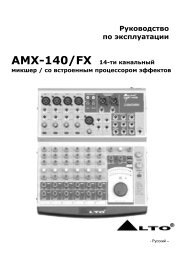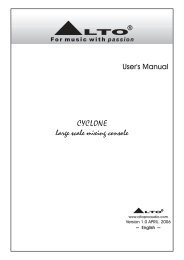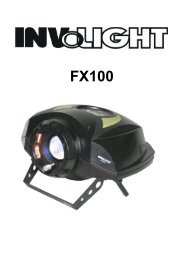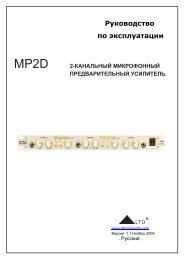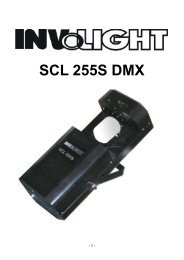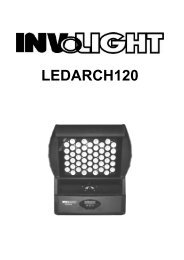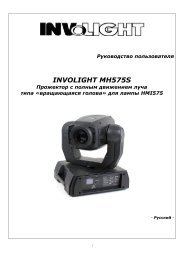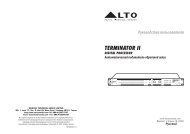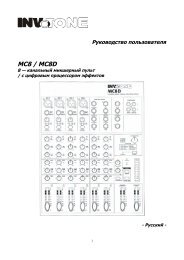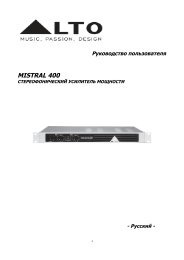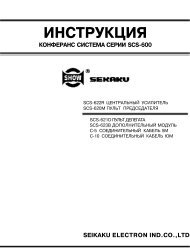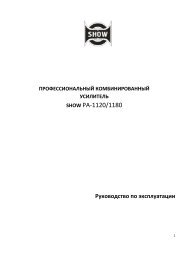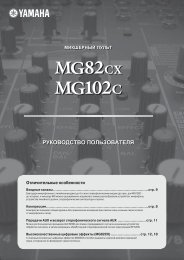PROEL BULK CABLE
PROEL BULK CABLE
PROEL BULK CABLE
Create successful ePaper yourself
Turn your PDF publications into a flip-book with our unique Google optimized e-Paper software.
<strong>BULK</strong> <strong>CABLE</strong><br />
MAIN <strong>CABLE</strong> REGULATIONS<br />
A) COPPER SPIRAL 90%<br />
B) COPPER BRAID 75%<br />
C) COPPER BRAID 90%<br />
D) ALUMINIUM/POLYESTER<br />
E) ALUMINIUM/POLYESTER + COPPER BRAID 95%<br />
F) DOUBLE COPPER BRAID 95% WITHOUT SEPARATION<br />
G) COPPER BRAID 95% + SEPARATING TAPE + COPPER BRAID 95%<br />
H) COPPER BRAID 95% + ALUMINIUM/POLYESTER + COPPER BRAID 95%<br />
I) COPPER BRAID 95% + MOMETAL + COPPER BRAID 95%<br />
LOW FUMES RELEASE<br />
Italian regulations:<br />
CEI 20-37/III<br />
International regulations: VDE 0472 teil 816<br />
LOW GAS TOXICITY RATE<br />
Italian regulations:<br />
IEC/TC20/WG12<br />
UTE .C .20-902 • HD 606.2 S1<br />
CEI 20-37/II<br />
International regulations: NF. C 20-454<br />
LOW CORROSIVE GAS<br />
RELEASE<br />
AFNOR X 70/100<br />
Italian regulations: CEI 20-37/I • CEI 20-37/2<br />
International regulations: VDE 0472 teil 813/815<br />
FLAME RESISTANCE<br />
IEC 754-1,754-2<br />
Italian regulations: CEI 20-35<br />
International regulations: MIL-C 17<br />
NF. C 20-453 • HD 602 S1<br />
VDE 0472 teil 804<br />
IEC 332.1 • UL 758<br />
NF. C 32-070 C2 • HD 405.1<br />
MAIN <strong>CABLE</strong> ELECTRICAL PARAMETERS<br />
RESISTANCE<br />
• (Measured in Ohm/length unit @ 20°C)<br />
The conductor resistance is of utmost<br />
importance for the determination of the<br />
signal’s capacity of transfer on the line of<br />
transmission. The higher is the resistance<br />
the more the transmitted signal will lose ts<br />
strength and as a consequence the ability to<br />
arrive at destination. Its value is given by the<br />
conductor’s material resistivity vs. its section.<br />
CAPACITANCE<br />
• (Measured in Farad/length unit) The<br />
capacity expresses the tendency of a<br />
dielectric material between conductors to<br />
store dielectric energy when a difference of<br />
potential exists between the conductors. It is<br />
always better to use low capacitance cables<br />
in order to allow transmissions over longer<br />
distances.<br />
NOMINAL IMPEDANCE<br />
• (Measured in Ohm) The impedance<br />
value indicates the total opposition that a<br />
transmission line offers to the flow of any<br />
varying current. In a long distance or high<br />
frequency transmission system, the most<br />
important components for impedance<br />
are: (a) correspondence between cable<br />
impedance and receiving system impedance<br />
(to avoid the signal’s reflection and<br />
distortion); (b) impedance uniformity (linked<br />
to conductor quality, cable geometry and<br />
dielectric uniformity).<br />
ATTENUATION<br />
• (Measured in Decibels/length unit) The<br />
attenuation determines the transmission<br />
level of a line (usually input voltage vs.<br />
output voltage). The signal’s attenuation<br />
turns into a decrease and a distortion of the<br />
signal with a loss in the voltage peak and an<br />
impulse slowing.<br />
VELOCITY OF PROPAGATION<br />
• (Measured in percentage) The velocity of<br />
propagation is the time required by a signal<br />
to travel through a transmission line. “Vp”<br />
indicates the transmission speed of electrical<br />
energy in a length of cable compared to<br />
speed of light in free space and it is expressed<br />
as a percentage (insulation material<br />
dielectric constant dependant value).<br />
WORKING TENSION<br />
• (Measured in Volts) The working tension<br />
of a cable is limited by its heating and by<br />
the dielectric softening temperature. The<br />
transferable power depends on materials<br />
and on cable dimensions as well as, of<br />
course, room temperature.<br />
112



